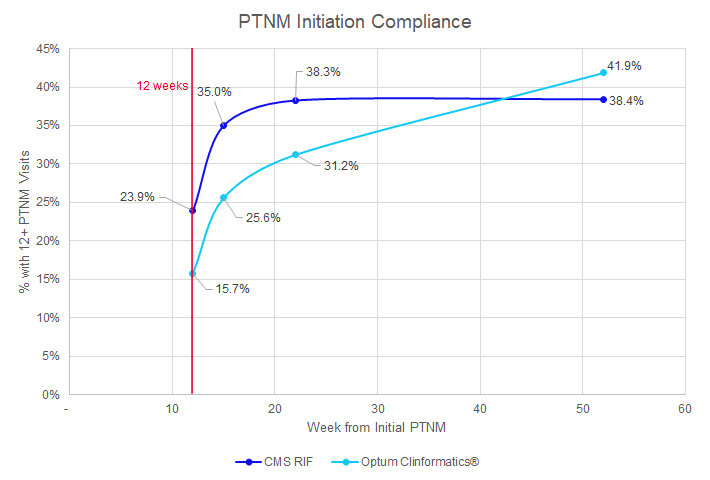Back
Introduction: Percutaneous Tibial Neuromodulation (PTNM) is a therapy for Overactive Bladder (OAB) delivered over 12 consecutive weekly sessions. However, little is known about the application and adherence of this treatment in a real-world setting. This analysis aims to summarize patients’ time to complete treatment course and examine trends of third-line therapy use--Sacral Neuromodulation (SNM) and Botox®--during and after the treatment course.
Methods: Optum’s Clinformatics® Data Mart (CDM) Database and CMS Research Identifiable File (RIF) healthcare claims were queried for adults diagnosed with urgency, frequency and urge incontinence and underwent PTNM treatment during 2019—allowing for a 1-year follow-up period. Patients were required to have continuous enrollment and pharmacy coverage. PTNM treatment within 30 days of a previous treatment was defined as part of the initial therapy. Compliance was defined as 12 PTNM-related visits. Primary outcomes were percentage of compliant PTNM-related visits within 1 year and total number of patients with SNM and Botox® within the same year, segmented by 12-, 15-, 22-, and 52-week periods.
Results: 3,087 patients were included from CDM and 9,727 patients from RIF data. Completion of initial treatment (12 treatments) increased over time; 16% at week 12 to 42% by week 52 and 24% to 38% for CDM and RIF data, respectively (Fig 1; both P<0.001). Similarly, utilization of third-line therapy increased over time and was higher for non-compliant patients: 0.2% of compliant and 0.8% of non-compliant CDM patients used Botox within 12 weeks. However, 4.9% of compliant and 6.4% of non-compliant CDM patients used Botox within 52 weeks; P=0.035. Similarly, SNM implant within 12 weeks was <1% for CDM patients, and within 52 weeks were 1.2% of compliant and 2.6% of non-compliant patients; P= 0.002. Patients in the RIF data followed similar trends.
Conclusions: Most patients are not compliant with the recommended treatment regimen of 12 PTNM treatments in 12 weeks. Non-compliant patients were more likely to pursue third-line treatment options. Signaling the effectiveness of PTNM therapy for patients with OAB symptoms may be severely underestimated. This is valuable in consideration of implantable tibial technology. SOURCE OF
Funding: No funding was provided for this analysis.

Moderated Poster Session
Session: MP37: Urodynamics/Lower Urinary Tract Dysfunction/Female Pelvic Medicine: Female Incontinence: Therapy II
MP37-15: Percutaneous Tibial Neuromodulation Initial Therapy Compliance and Subsequent Third-Line Treatment Patterns
Saturday, April 29, 2023
1:00 PM – 3:00 PM CST
Location: S401A

Priya Padmanabhan, MD (she/her/hers)
Professor
OU William Beaumont School of Medicine
Poster Presenter(s)
Introduction: Percutaneous Tibial Neuromodulation (PTNM) is a therapy for Overactive Bladder (OAB) delivered over 12 consecutive weekly sessions. However, little is known about the application and adherence of this treatment in a real-world setting. This analysis aims to summarize patients’ time to complete treatment course and examine trends of third-line therapy use--Sacral Neuromodulation (SNM) and Botox®--during and after the treatment course.
Methods: Optum’s Clinformatics® Data Mart (CDM) Database and CMS Research Identifiable File (RIF) healthcare claims were queried for adults diagnosed with urgency, frequency and urge incontinence and underwent PTNM treatment during 2019—allowing for a 1-year follow-up period. Patients were required to have continuous enrollment and pharmacy coverage. PTNM treatment within 30 days of a previous treatment was defined as part of the initial therapy. Compliance was defined as 12 PTNM-related visits. Primary outcomes were percentage of compliant PTNM-related visits within 1 year and total number of patients with SNM and Botox® within the same year, segmented by 12-, 15-, 22-, and 52-week periods.
Results: 3,087 patients were included from CDM and 9,727 patients from RIF data. Completion of initial treatment (12 treatments) increased over time; 16% at week 12 to 42% by week 52 and 24% to 38% for CDM and RIF data, respectively (Fig 1; both P<0.001). Similarly, utilization of third-line therapy increased over time and was higher for non-compliant patients: 0.2% of compliant and 0.8% of non-compliant CDM patients used Botox within 12 weeks. However, 4.9% of compliant and 6.4% of non-compliant CDM patients used Botox within 52 weeks; P=0.035. Similarly, SNM implant within 12 weeks was <1% for CDM patients, and within 52 weeks were 1.2% of compliant and 2.6% of non-compliant patients; P= 0.002. Patients in the RIF data followed similar trends.
Conclusions: Most patients are not compliant with the recommended treatment regimen of 12 PTNM treatments in 12 weeks. Non-compliant patients were more likely to pursue third-line treatment options. Signaling the effectiveness of PTNM therapy for patients with OAB symptoms may be severely underestimated. This is valuable in consideration of implantable tibial technology. SOURCE OF
Funding: No funding was provided for this analysis.

